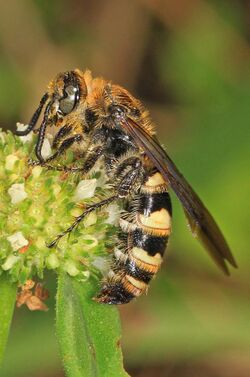Biology:Campsomerini
| Campsomerini | |
|---|---|

| |
| Dielis plumipes fossulana at Okaloacoochee Slough State Forest, Florida, USA | |
| Scientific classification | |
| Domain: | Eukaryota |
| Kingdom: | Animalia |
| Phylum: | Arthropoda |
| Class: | Insecta |
| Order: | Hymenoptera |
| Family: | Scoliidae |
| Subfamily: | Scoliinae |
| Tribe: | Campsomerini Betrem, 1972 |
| Synonyms | |
| |
Campsomerini is a cosmopolitan tribe of the family Scoliidae. An older, alternative representation of this group is as a subfamily, Campsomerinae.[1][2]
Taxonomy and phylogeny
Campsomerinae was originally described by Betrem in 1972[3] as a sister group to the Scoliinae comprising the scoliid wasps with two recurrent veins. This subfamily was further divided into the Campsomerini for species with two submarginal cells and Trielidini for species with three submarginal cells. Following the discovery of the genus Proscolia, the Campsomerinae and Scoliinae of Betrem were demoted to tribes, Campsomerini and Scoliini, under a newly-defined Scoliinae by Day et al. in 1981. In 1996, Argaman re-elevated the tribes to subfamily status, along with elevating Betrem's Trielidini to a separate subfamily as Colpinae. Argaman further subdivided his Campsomerinae into 8 tribes (Trisciloini, Tetrascitonini, Pseudotrielidini, Dobrobetini, Campsomerini, Colpacampsomerini, Megacampsomerini, and Dielidini) and his Colpinae into 5 tribes (Dasyscoliini, Curtaurgini, Heterelini, Colpini, and Trielidini) but did so without any phylogenetic analysis. Argaman's revisions to higher taxonomy, however, were not maintained in Osten's 2005 checklist, and Osten again treated the group as tribe Campsomerini. In a review of the scoliid wasps of North America, Kimsey et al. likewise maintained Campsomerini as a tribe but excluded the genus Colpa to maintain monophyly, with the suggestion that Colpa and its allies more likely either represent a separate tribe as Colpini or a subset of Scoliini.[2]
Genera
Genera within this tribe include:[4][5][6][7]
References
- ↑ "University of Wisconsin–Madison: Family Scoliidae". http://www.entomology.wisc.edu/irc/hymenopt/scoliida.html.
- ↑ 2.0 2.1 Khouri, Z.; Gillung, J.P.; Kimsey, L.S. (2022). "The evolutionary history of mammoth wasps (Hymenoptera: Scoliidae)". bioRxiv 10.1101/2022.01.24.474473.
- ↑ Boudinot, Brendon E.; Khouri, Ziad; Richter, Adrian; Griebenow, Zachary H.; van de Kamp, Thomas; Perrichot, Vincent; Barden, Phillip (2022). "Evolution and systematics of the Aculeata and kin (Hymenoptera), with emphasis on the ants". bioRxiv 10.1101/2022.02.20.480183.
- ↑ van Noort, Simon. "Classification and checklist of Afrotropical mammoth wasps". Iziko Museums of South Africa. https://www.waspweb.org/Vespoidea/Scoliidae/Classification/index.htm.
- ↑ Schulten, Gerard G. M. (2008). "The Flower Wasps (Hymenoptera: Scoliidae) of Papua Indonesia". https://www.papua-insects.nl/insect%20orders/Hymenoptera/Scoliidae/Scoliidae%20list.htm.
- ↑ Osten, T. (2005). "Checkliste der Dolchwespen der Welt (Insecta: Hymenoptera, Scoliidae). Teil 1: Proscoliinae und Scoliinae: Campsomerini. Teil 2: Scoliinae: Scoliini. Teil 3: Literatur" (in de). Bericht der Naturforschenden Gesellschaft Augsburg 62 (220–221): 1–62. https://www.zobodat.at/pdf/Ber-Naturf-Ges-Augsburg_062_2005_0001-0062.pdf. Retrieved 2014-06-24.
- ↑ Poole, R.W.; Gentili, P. (1996). Nomina Insecta Nearctica: A Check List of the Insects of North America. Vol 2: Hymenoptera, Mecoptera, Megaloptera, Neuroptera, Raphidioptera, Trichoptera. Rockville, Maryland: Entomological Information Services. pp. 793 pp. ISBN 1-889002-02-X.
Wikidata ☰ Q21228895 entry
 |

